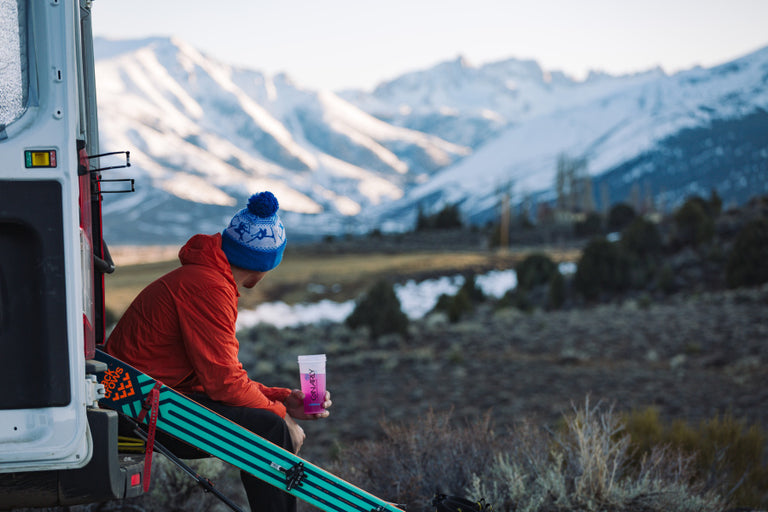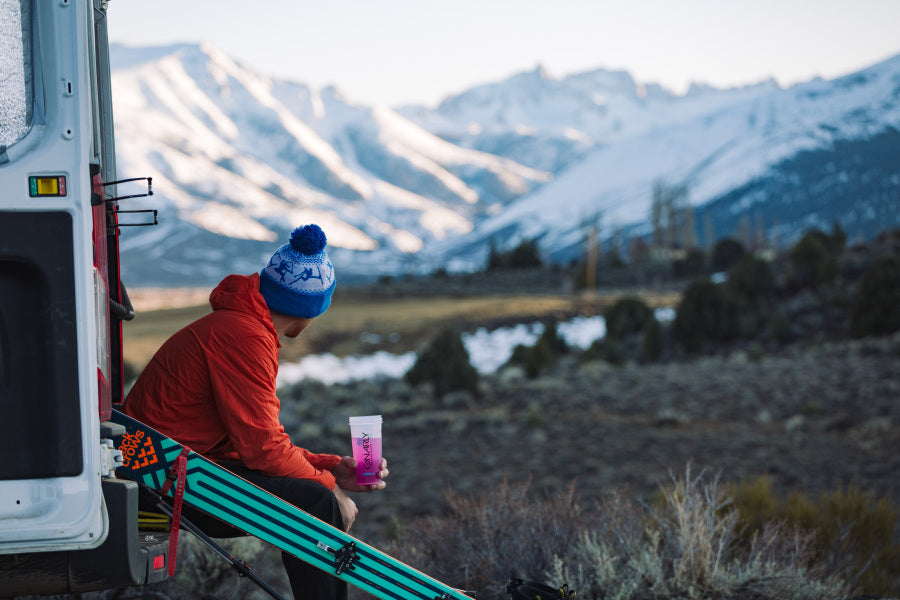You might feel confident with fueling choices in the summer, but winter is a whole different story. Cold temperatures seem to complicate things a bit more—frozen gels, chews, and hydration mixes cause logistical fueling issues, not to mention impacted hunger and thirst cues.
The question is not just, ”how much?” but logistically how do you fuel for winter sports like long ski tours and nordic ski outings?
Let’s first take a deeper dive into what your baseline inter-workout fueling needs during endurance exercise and then look at winter specifics to help fuel your next adventure.

3 Inter-workout Fueling Components:
1. Fluids: Fluids act in a number of ways to keep the body running smoothly during endurance exercise including: maintaining blood plasma volume, delaying fatigue, preventing injury, and adapting to temperature stress. Even a small amount of dehydration (2-3% total body weight loss) can affect performance. Fluids needs will vary depending on sweat rate, climate, and altitude, but a good starting place is aiming for 16-20oz of intake per hour.
Winter Specific Recommendations:
Fluid intake in the winter can be tricky. When it’s hot outside, we sweat more and feel thirstier. Unfortunately, in the winter, the cold weather can cause our blood vessels to constrict, which sends blood to our core and blunts the thirst response. In addition, colder air tends to be drier and when we breathe it in, our lungs warm the air, humidify it, and exhale some moisture when we breathe out.
Because of these factors, you must be more intentional and diligent about fluid intake in the winter. Having a set target per hour and even setting an alarm on your watch can help remind you to consume enough. While you might need a little less fluid intake than during your normal summer adventures, hourly intake should not vary significantly from summer to winter.
Prevention of fluids from freezing can be a key to ensuring you can even achieve fluid intake goals. Using a bladder or bottles with hot water vs. cold to start can help. Other solutions include insulating your bottles with a wool sock or other insulating materials, or creating a front facing pouch for your body to keep your fluids closer to your core.
2. Sodium: When it comes to electrolytes and fueling, sodium is king because it is lost in the highest amounts in sweat. Not only does it play a key role in fluid balance, it helps to play a key role in sugar transport in the small intestine, too. A good starting point for most endurance athletes is an intake of 250-500mg of sodium per hour. If you are a saltier sweater, exercising at higher altitude or in the heat, aim for the upper end of the recommended range.
Winter Specific Recommendations: If you are exercising at a higher altitude, your
sodium needs may be higher than normal. Keep in mind that you are still sweating in the winter, even moreso if you wear heavier articles of clothing. Having hot Gnarly Fuel2O electrolyte mix or carrying something like Saltstick chewables can help you reach your targets!
3. Calories/Carbohydrates: These act as the gasoline to fuel your fire during your workouts. Your body contains a finite amount of stored carbohydrate, called glycogen (about 2,000 calories worth), which is used for an efficient source of energy production during times when food is not available. The stored fuel will get you about 90 minutes to 2 hours worth of endurance activity without fatigue. Once your glycogen stores are emptied, your body can make energy from fat stores as well as muscle protein breakdown, but the process is much more inefficient and can leave you feeling fatigued or rather, the dreaded “hitting the wall” experience. This is why consuming outside sources of calories/carbohydrates can be beneficial for endurance athletes. A good rule of thumb is to aim for 200-300 calories of intake per hour or 40-90G of mixed glucose and fructose carbohydrates per hour.
Winter Specific Recommendations:
Calorie/carbohydrate intake typically comes from a variety of sources while exercising including gels, chews, food blends, hydration mixes, and whole food options. The key to figuring out what will work best for you in the winter is experimentation. Oftentimes, gels and chews that work well in the summer freeze quickly in the winter. Holding your gel or chew close to your body can help, but not always. Hydration mixes should be made with hot water vs. cold, and just using a hydration mix alone lowers the freezing point of the solution. Whole food options like muffins and cookies might just be your best bet for fueling your winter adventures as they tend to resist freezing and can be easily consumed quickly. However, portability needs to be considered when making your choices, which is why building and practicing your fueling plan in your training is essential to fueling success!





